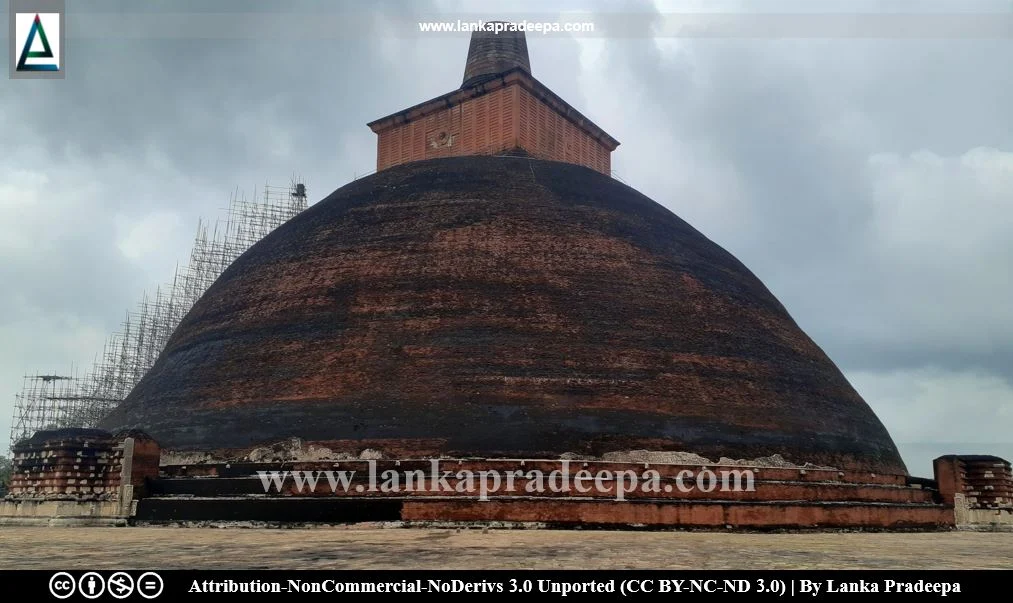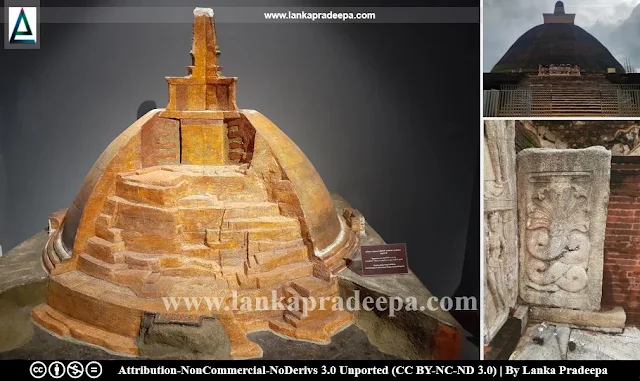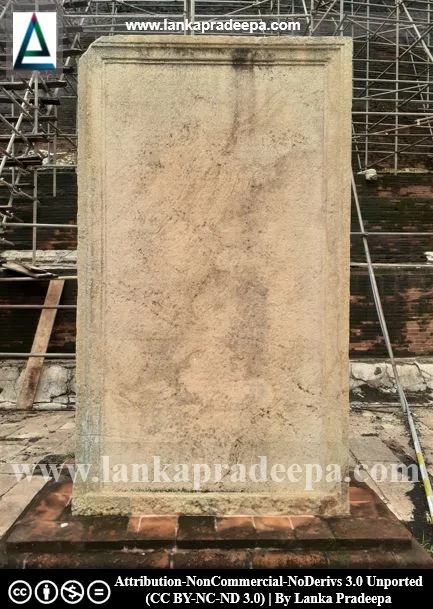
Jethavanaramaya, also known as Denanaka or Dena Vihara/Dena Vehera (Sinhala: ජේතවනාරාමය; Tamil: ஜேத்தவனராமயா), is an ancient Buddhist monastery situated east of Abhaya Wewa in Anuradhapura, Sri Lanka. The colossal Stupa of this monastery is considered the largest brick structure in the world (Held & de Panthou, 2001; Lokeshwara et al., 2023; Ranaweera, 2004; Ranaweera & Abeyruwan, 2006)
History
The temple founded by Mahasena
The Jetavana monastery is a creation of King Mahasena (276-303 A.D.), the first Sinhala king who embraced Mahayana Buddhism (Bopearachchi, 2020; Jayasuriya, 2016; Nicholas, 1963; Senanayaka, 2020; Wikramagamage, 2004). According to the chronicle Mahavamsa, Mahasena who was against to Maha Vihara fraternity destroyed some of its buildings and used the materials to build new structures at Abhayagiri Viharaya (Jayasuriya, 2016). Ignoring the protests of Maha Vihara monks, the king established the Jetavanaramaya within the precincts of the Maha Viharaya and offered it to Tissa Thera of Dakkhina Vihara, a monk who was expelled from the order of Maha Vihara but had won the admiration of the king later (Dias, 2001; Nicholas, 1963; Senanayaka, 2020; Wikramagamage, 2004). As mentioned in the Nikaya Sangrahaya, Tissa Thera was a monk who belonged to the Sagalika school and therefore, the Jetavanarama became one of the three major fraternities of the Buddhist order in the country along with Maha Viharaya and Abhayagiriya (Bopearachchi, 2020; Dias, 2001). Jetavanaram monastery served as the headquarters for the Sagalika sect until the 12th century A.D. (Wikramagamage, 2004).
Nandana Pleasure Grove

Jetavanaramaya is said to have been established within the park named Nandana (Jayasuriya, 2016; Senanayaka, 2020; Wikramagamage, 2004). Arhat Mahinda (3rd century B.C.), the messenger of Buddhism to Sri Lanka had stayed for seven days at this site to preach the Dharma of the Buddha (Jayasuriya, 2016; Wikramagamage, 2004). In recognition of this event, the park was renamed Jotivana which means 'the place where the holy one had made the true doctrine shine forth' (Jayasuriya, 2016; Senanayaka, 2020; Wikramagamage, 2004). It is said that this land was started to be known as Isibhumangana (courtyard of the sage) because Arhat Mahinda and his associate monks were cremated at this site after their deaths (Jayasuriya, 2016; Senanayaka, 2020; Wikramagamage, 2004). The archaeological evidence that supports this belief has been found at the site (Jayasuriya, 2016; Wikramagamage, 2004).
As mentioned in Perakumba Siritha, an ancient text belonging to the 15th century, the portion of the Pati Dhatuwa relic of the Buddha has been enshrined in the Jetavana Stupa (Senanayaka, 2020).
Jetavana entourage

Jetavana entourage is extending in about 80 hectares (Jayasuriya, 2016). All essential features of a Buddhist monastic institution such as the Stupa, Bodhi-tree shrine, Pilimage (image house), Uposathagara (chapter house), Sannipatasala (assembly hall), living quarters, refectories,
ponds, etc. are found here. Kings such as Mittasena (428-429 A.D.), Dhatusena (455-473 A.D.), Mahanaga (569-571 A.D.), Aggabodhi I (571-604 A.D.), Aggabodhi II (604-614 A.D.), Moggallana III (614-619 A.D.), Aggabodhi IV (667-683 A.D.), Aggabodhi VI (733-772 A.D.), Dappula II (815-831 A.D.), Sena I (833-853 A.D.), Sena II (853-887 A.D.), Udaya IV (946-954 A.D.), Mahinda IV (956-972 A.D.), Parakramabahu I (1153-1186 A.D.) made repairs and
additions to the development of the temple (Nicholas,
1963).
Jetavana Stupa

The Stupa is the main and most impressive feature of the whole monastery complex. It is the largest and tallest brick monument in the world (Jayasuriya, 2016; Ranaweera, 2004). Its original height was a little over 120 m and in the 4th century A.D., it was the third tallest monument in the world after the two pyramids at Gizeh in Egypt (Jayasuriya, 2016; Lokeshwara et al., 2023; Ranaweera, 2004). The Stupa including the sand-strewn terrace covers an area of about 3 hectares (Jayasuriya, 2016). Presently, it rises up to a height of 70.7 m (from platform to the broken spire) and has a diameter of 102 m at the platform (Lokeshwara et al., 2023).
After being constructed by King Mahasena (276-303 A.D.), the Stupa was renovated and repaired by several kings during various periods. King Mittasena (428-429 A.D.) made a gateway to the Stupa and King Dhatusena (455-473 A.D.) restored and gilded the umbrella of it (Nicholas, 1963). King Mahanaga (569-571 A.D.), Aggabodhi I (571-604 A.D.), and Moggallana III (614-619 A.D.) made further improvements to the Stupa (Nicholas, 1963). King Parakramabahu I (1153-1186 A.D.) last restored the Stupa to a height of 210 feet in the 12th century A.D. (Jayasuriya, 2016; Nicholas, 1963).
Thereafter, the Stupa didn't receive the patronage of anyone until the 19th century. During the second half of the 19th century, the British Administration of Ceylon and then the Department of Archaeology partly excavated and conserved the Stupa which had been swallowed by thick vegetation (Senanayaka, 2020). In 1981, the Central Cultural Fund began archaeological research and conservation work at the site (Ranaweera & Abeyruwan, 2006).
Frontispieces (Vahalkada)

Four frontispieces are there at the base of the Jetavana Stupa facing cardinal points. The steles of them have been freely decorated with floral designs and figure sculptures (Jayasuriya, 2016; Senanayaka, 2020). Remnants of these paintings are still visible in some places on the frontispieces and some parts are presently preserved in the Jetavanarama Museum (Senanayaka, 2020; Wikramagamage, 2004). The frontispieces of Ruwanweliseya, Mirisawetiya, and Jetavana Stupas are said to be basically similar to each other (Wikramagamage, 2004).
The sculptures on frontispieces are dated by scholars to the 3rd century A.D. (Bopearachchi, 2020). The Nagaraja snake with seven hoods (Muchalinda?), Nagaraja, Nagini, Cakravartin, Kubera, Kalpavrkshas, Tusita heaven and Sibijataka are some of the sculptures and paintings found in the frontispieces (Bopearachchi, 2020).
Other monuments belong to the Jetavana Vihara complex
Other monuments within the Jetavana monastery premises include the Uposathagara (the Chapter House), Danasala (the refectory), Pancavasa (monks' living units), Patimaghara (the image house), Thimbiri Pokuna, Yaturu Pokuna, and the building of Buddhist Railing.
Artefacts
A large number of artefacts were unearthed during the Jetavana Vihara Project that was carried out at the monastic site by the Cultural Triangle. Some of them are presently on display at Jetavanarama Museum and Colombo National Museum.
Relief sculpture of Mahamaya

A limestone slab depicting three women was found near the building known as Buddhist Railing (Jayasuriya, 2016). It had been used to pave the floor of a building but it is not a paving stone and is believed to have been brought from another site, probably from the Stupa (Jayasuriya, 2016). Scholars concluded that this sculpture belongs to the Amaravati School of Andra, India (Jayasuriya, 2016; Wikramagamage, 2004). According to the view of Wikramagamage, this may have been imported from Andra or had been done locally by artists from Andra (Wikramagamage, 2004).
The slab depicts Queen Maha Maya (the mother of the Buddha) who is being conducted to the precincts of a Sala tree for her confinement (Jayasuriya, 2016; Wikramagamage, 2004).
This inscription was discovered from the premises of the Jetavana monastery in 1893, by the then Archaeological Commissioner H. C. P. Bell (Paranavitana, 2001; Ranawella, 2005). It has been erected to regulate the monastic life of monks connected with five great residences of the Mahavihara fraternity in Anuradhapura.
These golden plates were discovered at the Jetavanarama monastery during an archaeological excavation done under the UNESCO-Sri Lanka Cultural Triangle Project (Wikramagamage, 2004). The epigraph on the plates contains a portion but an exact copy of the Mahayana Buddhist text Pancavimsati-sahasrika – Prajnaparamitasutra, one of the earliest texts written in about the 2nd century A.D.
The micro gold carving
A very small gold piece containing 14 lotus flowers has been found on the Jetavana premises and it is presently on the display at the Jetavanarama museum (Wikramagamage, 2004). As per the view of some, this type of micro carving has not been found in any other country in Asia (Wikramagamage, 2004).
Confusion with Abhayagiri Viharaya
Jetavanarama monastery complex had been incorrectly identified for a long time as the ancient Abhayagiri Viharaya (Senanayaka, 2020). However, this confusion was solved when a pillar inscription of the 8-10 centuries A.D. was discovered at the western frontispiece of the Jetavana Stupa in which this temple is mentioned as Dena Vehera, the name used in the contemporary time in ancient Sri Lanka to identify the present Jetavanarama Viharaya (Senanayaka, 2020).
Jetavanarama museum was opened to the public in 1995 (Senanayaka, 2020). Many artefacts discovered from the Jetavanarama premises are
displayed in the museum (Rambukwella, 2014; Senanayaka, 2020).

.
References
1) Bopearachchi, O., 2020. Roots of Sri Lankan Art. Department of Archaeology, Sri Lanka. ISBN: 978-955-7457-31-4. pp.85-97.
2) Dias, M, 2001. The growth of Buddhist monastic institutions in Sri Lanka from Brahmi inscriptions. Epigraphia Zeylanica, Vol. VIII.
Department of Archaeology Survey. ISBN: 955-9264-04-4. pp.44-45.
3) Held, S.; de Panthou, P., 2001. Sri Lanka; the Island of Ceylon. Editions Herme, Paris. ISBN:2 86665 355 6. p.233.
4) Jayasuriya, E., 2016. A guide to the Cultural Triangle of Sri Lanka. Central Cultural Fund. ISBN: 978-955-613-312-7. pp.36-46.
5) Lokeshwara, P.A.G.W.S., Thilakarathna, T.N.M., Wijewardena, L.S.S., Karunananda, P.A.K. and Pallewatta, T.M., 2023. Seismic Performance of Three Ancient Stupas in Anuradhapura, Sri Lanka. Engineer, 56(01), pp.21-30.
6) Nicholas, C. W., 1963. Historical topography of ancient and medieval Ceylon. Journal of the Ceylon Branch of the Royal Asiatic Society, New Series (Vol VI). Special Number: Colombo. Royal Asiatic Society (Ceylon Branch). pp.146-147.
7) Paranavitana, S. 2001. Dias, M. (Ed). Inscription of Ceylon: Volume II. Part II. Archaeological Survey Department. pp.189-192.
8) Rambukwella, M.W.C.N.K., 2014. Heritage representation in culturally diverse societies: a case study of the Colombo National Museum in Sri Lanka (Doctoral dissertation, School of Museum Studies). p.419-420.
9) Ranaweera, M.P., 2004. Ancient Stupas in Sri Lanka-Largest brick structures in the World. CHS Newsletter No. 70, December 2004, London, Construction History Society.
10) Ranaweera, M. and Abeyruwan, H., 2006. Materials used in the construction, conservation, and restoration of ancient stupas in Sri Lanka. In Proceedings of the second International Congress on Construction History. pp.2573-2586.
11) Ranawella, S. (Ed.), 2005. Sinhala inscriptions in the Colombo National Museum: Spolia Zeylanica. Vol 42. (2005). Department of National Museums, Sri Lanka. pp.3-5
12) Senanayaka, P., 2020. Jetavana Kauthukagaraya (In Sinhala). Central Cultural Fund. ISBN: 978-955-613-415-5. pp.1-56.
13) Wikramagamage, C., 2004. Heritage of Rajarata: Major Natural, Cultural and Historic sites: Colombo. Central Bank of Sri Lanka. pp.126-139.
4) Jayasuriya, E., 2016. A guide to the Cultural Triangle of Sri Lanka. Central Cultural Fund. ISBN: 978-955-613-312-7. pp.36-46.
5) Lokeshwara, P.A.G.W.S., Thilakarathna, T.N.M., Wijewardena, L.S.S., Karunananda, P.A.K. and Pallewatta, T.M., 2023. Seismic Performance of Three Ancient Stupas in Anuradhapura, Sri Lanka. Engineer, 56(01), pp.21-30.
6) Nicholas, C. W., 1963. Historical topography of ancient and medieval Ceylon. Journal of the Ceylon Branch of the Royal Asiatic Society, New Series (Vol VI). Special Number: Colombo. Royal Asiatic Society (Ceylon Branch). pp.146-147.
7) Paranavitana, S. 2001. Dias, M. (Ed). Inscription of Ceylon: Volume II. Part II. Archaeological Survey Department. pp.189-192.
8) Rambukwella, M.W.C.N.K., 2014. Heritage representation in culturally diverse societies: a case study of the Colombo National Museum in Sri Lanka (Doctoral dissertation, School of Museum Studies). p.419-420.
9) Ranaweera, M.P., 2004. Ancient Stupas in Sri Lanka-Largest brick structures in the World. CHS Newsletter No. 70, December 2004, London, Construction History Society.
10) Ranaweera, M. and Abeyruwan, H., 2006. Materials used in the construction, conservation, and restoration of ancient stupas in Sri Lanka. In Proceedings of the second International Congress on Construction History. pp.2573-2586.
11) Ranawella, S. (Ed.), 2005. Sinhala inscriptions in the Colombo National Museum: Spolia Zeylanica. Vol 42. (2005). Department of National Museums, Sri Lanka. pp.3-5
12) Senanayaka, P., 2020. Jetavana Kauthukagaraya (In Sinhala). Central Cultural Fund. ISBN: 978-955-613-415-5. pp.1-56.
13) Wikramagamage, C., 2004. Heritage of Rajarata: Major Natural, Cultural and Historic sites: Colombo. Central Bank of Sri Lanka. pp.126-139.
Explore Other Nearby Attractions
Location Map (Google)
This page was last updated on 15 December 2023

